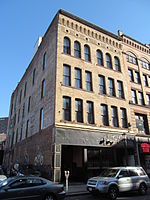Kennedy-Worthington Blocks
1872 establishments in MassachusettsBuildings and structures in Springfield, MassachusettsCommercial blocks on the National Register of Historic Places in MassachusettsNational Register of Historic Places in Springfield, Massachusetts

The Kennedy-Worthington Blocks are three historic commercial and industrial buildings at 1585-1623 Main Street and 166-190 Worthington Street in downtown Springfield, Massachusetts. Built in the 1870s and 1880s, with a major restyling to two of them in 1912, the buildings were a major factor in the urban development of the area north of the city's traditional core. They were listed to the National Register of Historic Places in 1979.
Excerpt from the Wikipedia article Kennedy-Worthington Blocks (License: CC BY-SA 3.0, Authors, Images).Kennedy-Worthington Blocks
Main Street, Springfield
Geographical coordinates (GPS) Address Nearby Places Show on map
Geographical coordinates (GPS)
| Latitude | Longitude |
|---|---|
| N 42.104166666667 ° | E -72.593333333333 ° |
Address
Main Street 1623
01115 Springfield
Massachusetts, United States
Open on Google Maps










